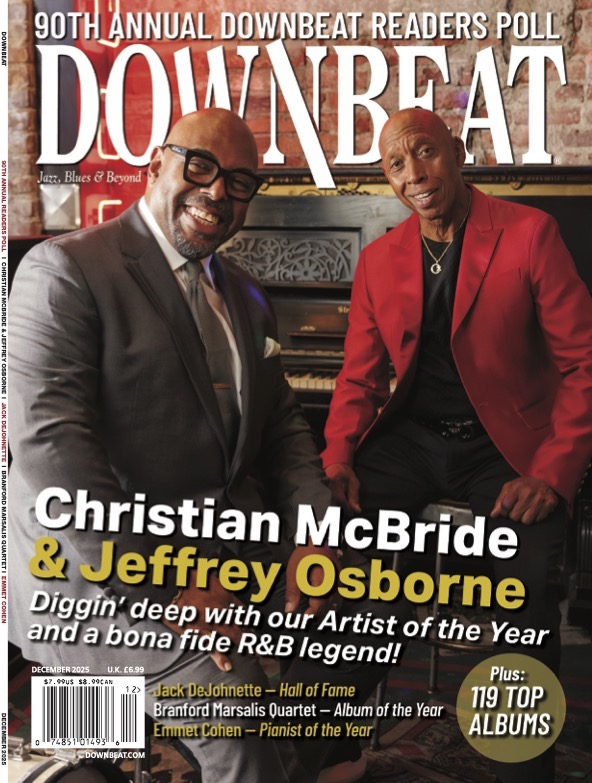By Michael J. West
Embedded in a trio with Christian McBride and Jack DeJohnette, Ivan Farmakovskiy would get credit merely for keeping his head above water. The Muscovite pianist does a hell of a lot more than that.
Recorded in 2010, Epic Power (his sophomore recording) offers up Farmakovskiy’s abilities as both pianist and composer: He wrote seven of the album’s eight tunes and arranged its one cover, a sexy rendition of Lennon & McCartney’s “And I Love Her.” The pianist maintains a hard-bop vibe throughout; between the vibe and the company he keeps, hard-driving swing is a must, and Farmakovskiy delivers. The opening “Soul Inside Out” is ablaze from the start, and he runs away with that fire in his solo. “Professor” gives him a funky (in the Horace Silver sense) workout that makes room for a bluesy, groovy solo. But mid-uptempo is more the pianist’s speed. “Conciliation,” a lithe, pretty waltz based on “The Lady Is A Tramp,” inspires perhaps his best improvisational work: Greased-keyboard chops yield a rhythmically inventive line whose melodic phrases turn in on themselves in brilliant curlicues and trotting syncopations.
But it’s not all about Farmakovskiy. He’s a highly interactive leader, letting DeJohnette, in particular, shape his solos on “The Day Before” and “Orange” at least as much as he shapes their comps. His lightning runs on the former seem directly in response to DeJohnette’s fluttering brushwork, with the two conversing on the latter. Although there’s less direct engagement with McBride (whose arco solo on “And I Love Her” is an album highlight), their empathy is crystal clear. What a splendid trio, and record, this is.
By Ed Enright
This vinyl reissue of Walter “Furry” Lewis’ Back On My Feet Again from 1961 presents the iconic country blues singer and guitarist in the initial years of his historic career revival. Known for his soulful vocals and skillful, light touch on guitar, Lewis was among the earliest active bluesmen to find fame later in life amid the ’60s folk/blues revival. Born in the 1890s, Lewis began his career as a performer on Beale Street in Memphis, and in the late 1920s he cut his first sides for Vocalion and Victor. But during the Great Depression, he retired from music and turned to working menial jobs to make ends meet. Thirty years later, Lewis was given a second chance at stardom when music historian Sam Charters sought out the bluesman and encouraged him to return to the studio. His second album from that fertile period, recorded at Sun Studios in Memphis and originally issued via Prestige Records’ Bluesville imprint, Back On My Feet Again finds Lewis in a stripped-down setting, accompanied only by his acoustic guitar as he employs his signature stylings — including nimble finger-picking and explosive bursts of slide playing — and revisits several of his early recordings, including “John Henry” and “Big Chief Blues,” while weaving in traditional material like “Shake ’Em On Down” as well as newer compositions, “Back On My Feet Again” among them. As Back On My Feet Again ably demonstrated at the time, Lewis’ talents never wavered despite his lengthy break from music, and he ended up enjoying a career resurgence for the last two decades of his life (he passed in 1981). The album sounds better than ever now that it’s been remastered for 180-gram vinyl pressings that are currently available for pre-order (with a release date of Aug. 1). Back On My Feet Again can also be purchased as a download in hi-res and standard digital audio formats.
Another long-out-of-print blues classic being brought back to vinyl (and digital download) by Bluesville Records is Memphis Slim At The Gate Of Horn, recorded in 1959 for Vee-Jay. Named for his hometown and known for his commanding vocals and rollicking piano technique, Peter “Memphis Slim” Chatman (1915–’88) was one of the blues’ most versatile players and songwriters. He spent much of his youth touring the Southern bar and dance hall circuit before relocating to Chicago in 1939, where he found work as a sideman before finding his own voice as a performer and leading his own group starting in the mid-’40s. Slim and his band released a string of R&B hits, including “Blue And Lonesome,”“Mother Earth,” “The Come Back,” the 1948 chart-topper “Messin’ Around” and “Nobody Loves Me,” a 1949 B-side better known as “Every Day I Have The Blues.” When Slim recorded this collection of his best-known songs at The Gate of Horn, a Chicago folk club, he was joined by his longtime bandmates (including Matt “Guitar” Murphy and a solid horn section), and although their relatively short, well-paced set wasn’t captured during a live performance before an audience, it presents the superb pianist and always-clever wordsmith in his element, at the peak of his legendary blues powers.
By Ed Enright
Points In Time by John Yao and His 17-Piece Instrument is more than a hard-swinging recording from an ace large ensemble led by a forward-thinking composer-arranger (and distinguished trombone voice). It’s also a commemoration of tandem anniversaries currently at the forefront of Yao’s memory: his arrival on the New York jazz scene 20 years ago, and the 10 years that have passed since he released his first big band album, the acclaimed Flip-Flop. Inspired by these two milestones, the album is informed by a number of professional and deeply personal experiences that have marked his two decades as a bandleader and sideman in the Big Apple. The music reveals the major strides Yao and his collaborators have taken since Flip-Flop made the JY-17 a widely known entity in the lineage of the iconic Vanguard Jazz Orchestra. For the album’s repertoire, Yao chose favorite tunes from throughout his discography — revising small-group compositions in vibrant new arrangements — as well as new pieces he penned during intervening years, plus a fresh take on Herbie Hancock’s “Finger Painting.” The eight fully fleshed-out arrangements on Points In Time largely embrace pillars of classic big band form like sax section solis, trombone choir passages, call-and-response exchanges between the reeds and brass, straightahead soloing (both muscular and lyrical), a persistently swinging feel (at all tempos) and traditional shout-chorus climaxes. But Yao, who was appointed to the 100th class of Guggenheim Fellows earlier this year in the field of Music Composition, isn’t averse to modernism, as heard on his boldly assertive “The Other Way” — a 12-tone adventure that quite possibly indicates new directions for the JY-17’s planned third outing. Outness of a whimsical variety rears its head on the brooding “Triceratops Blues,” a tune Yao originally penned for his three-horn quartet Triceratops, with alto saxophonist Billy Drewes and bass trombonist Max Seigel conjuring Late Cretaceous period grunts, groans and growls during their solo spots. Other musicians with longtime connections to Yao in this rendition of the JY-17 include tenor saxophonists Tim Armacost and Rich Perry, trombonist Matt McDonald, trumpeters Nick Marchione and David Smith, bassist Robert Sabin and drummer Andy Watson. Yao himself solos on “The Other Way” and “Early Morning Walk,” reminding us of this visionary artist’s round instrumental tone and rhythmic drive as an improviser.
By Frank Alkyer
Jaleel Shaw has been quiet. Not from a sideman standpoint; he’s been performing brilliantly with vibraphonist Stefon Harris and in Dave Holland’s Quartet. But it’s been 13 years since the soulful 47-year-old alto saxophonist has released a recording as a leader. Well, that all changes as of Friday, July 11. Shaw’s new recording, Painter Of The Invisible (Changu Receords), is a beast of beautiful storytelling that’s well worth the wait. This is a thoughtful, well-paced program of 11 songs written from the heart to remember people and places that have touched him along the road.
“Beantown” serves as a hip ode to Boston and Shaw’s days studying at Berklee College of Music. Bassist Ben Street lays down a bopping groove before pianist Lawrence Fields and Shaw kick in and start dancing around that groove. And Shaw comes strong with a fountain of ideas on saxophone — no clichés here, just solid, instant improvisation. “Distant Images” serves as a heartfelt homage to his grandmother who passed in 2016. You can hear every breath as it passes through the mouthpiece and into his horn, and out pours love. He’s joined here by guitarist Lage Lund, who lays down a touching solo. Drummer Joe Dyson swings strong and solid throughout the set, shining on tunes like “Baldwin’s Blues” (for writer James Baldwin) and “Tamir,” a hard-driving classic to honor the memory of Tamir Rice, the 12-year-old boy who was killed by police in Cleveland, Ohio. Shaw unleashes his fury felt over the loss of a child at the hands of those who take an oath to protect and serve.
He writes and plays so beautifully about those we’ve lost. Vibraphonist Sasha Berliner joins him for the dreamy ballad “Gina’s Ascent,” written for his cousin who passed in 2020. Shaw’s alto blows slow and mournful on “Meghan,” written for music industry star Meghan Stabile, who passed in 2022 at the age of 39. The album finishes with “Until We Meet Again,” a short, lovely note to fellow saxophonist Casey Benjamin, who passed away last year at the age of 46.
The album drips with love lost but also reveals Shaw’s own growth and his dedication to the memories of those who have gone on. “When I say ‘painter of the invisible,’ it’s about a people who have always been overlooked in some way,” says Shaw. “That’s part of what this album is about — our experience. As a Black man, I’ve felt invisible at times.”
As long as Jaleel Shaw has a saxophone and stories to tell about people who teach us what it means to be alive, he’ll remain highly visible to those who are wise enough to listen.
By Michael J. West
No mere repertory exercise, this — perhaps even less so than drummer Terri Lyne Carrington’s inspired 2013 update of Ellington/Roach/Mingus’ Money Jungle. Always in touch with her social conscience, Carrington reimagines Max Roach’s 1960 We Insist! Freedom Now Suite from top to bottom with an eye toward its current-day relevance.
The scope of her reconceptualization is clear in her choice of collaborator. Absurdly gifted though she is, vocalist Christie Dashiell’s instrument doesn’t have the urgent authority of Abbey Lincoln’s (could anyone’s?). Instead, she deals in subtlety and understatement: On two different versions of “Freedom Day,” her “whisper, listen” leans far more in the former direction; her “Driva’man” expresses sadness and fatigue rather than raw effrontery. Dashiell appeals to our compassion, not our rage, and it is in its own way every bit as effective.
It’s not just the vocal that’s different, though. Carrington changes the aforementioned “Driva’man” from an aggressive work song to a pathos-laden piece of Afropop, with bassist Morgan Guerin, guitarist Matthew Stevens and percussionist Weedie Bramah meeting her in beautiful polyrhythmic convergence. The suite’s most incendiary section, “Triptych,” remains shaped by wordless vocals — but also a section of shouted slogans by Dashiell, offset with solos and interplay from trumpeter Milena Casado, bassist Devon Gates, multi-reedist Guerin (who here plays saxophones and bass clarinet) and Carrington. If it’s not the primal screams that Lincoln made infamous, it instead carries the weight of the 65 years of history that have lapsed in between the two versions of the work.
What, then, does Carrington and Dashiell’s re-envisioning of We Insist! say about the world on the near side of those 65 years? Black America is no less angry today than it was then (nor should it be). Perhaps, though, there’s a hope that the rest of us — living in a media-saturated world that constantly beats us over the head with facts and fictions alike — can better relate to anguish and exhaustion. Here’s hoping we get it.
By Ed Enright
When you live, work and play in New York, the city’s renowned culture is there for the taking. But even if your day-to-day pursuits are of the utmost sophistication, there’s no escaping the raw grit and inherent riskiness of urban life. Nobody knows that better than Michael Dease, who spent more than a decade of his formative years in the Big Apple, and whose latest double album, City Life, bustles like Seventh Avenue at rush hour and soars as high as the Empire State building. It’s the third recording project on which Dease has collaborated with the prolific composer Gregg Hill, who succeeds in bringing out a more adventurous side of the versatile trombonist, known among listeners as a torchbearer for the jazz tradition. Both of the wide-ranging albums that constitute City Life feature Dease with a rhythm section of bassist Linda May Han Oh and drummer Jeff “Tain” Watts. They perform as a trio for the entirety of Disc 1, with the leader’s daughter, the vital tenor saxophonist Brooklyn Dease, contributing vocals on two tracks. The core trio expands into a quintet on Disc 2 as Dease welcomes pianist Geoffrey Keezer and tenor saxophonist Nicole Glover into the bustling fray, with bassist Jared Beckstead-Craan, Dease’s former student, taking Oh’s place on two tracks. City Life’s two sets revolve around 12 new pieces by Hill, as well as a pair by Dease (who recently received a Guggenheim Fellowship for Music Composition), two lesser-known works from the vast oeuvre of bebop-’bone icon J.J. Johnson, one by the late guitarist Emily Remler, one by saxophonist Greg Tardy and one by saxophonist Sharel Cassity. Sporting such edgy titles as “Danger Zone,” “Say Whaaat?” and “Mr. Hurt,” and evoking images of the quieter, more refined aspects of urban living in polished gems like “Tea Time” and “Rainy Afternoon,” this wide-ranging collection of mostly original music vibrantly captures the kaleidoscopic colors and multifarious flavors of life in the big city.





